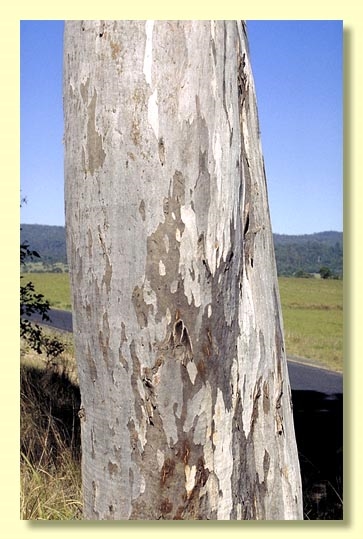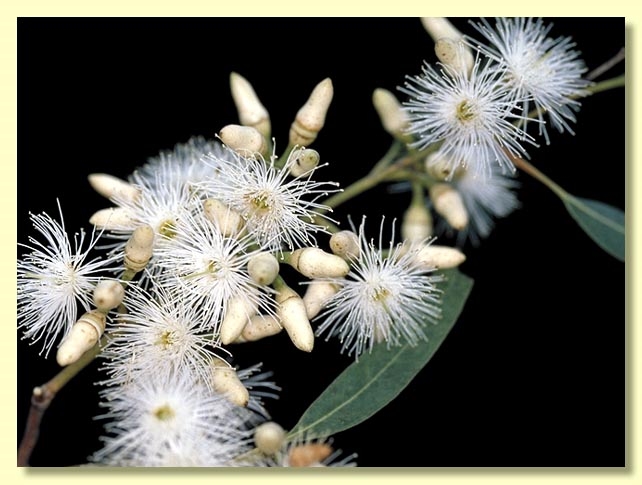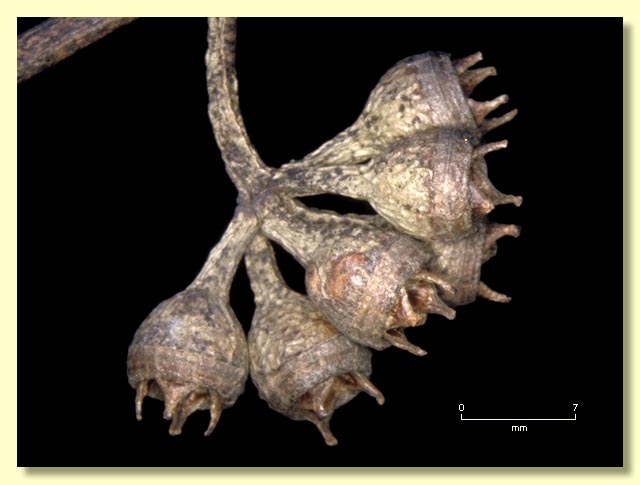Euclid - Online edition
Eucalyptus seeana
Eucalyptus | Symphyomyrtus | Liberivalvae
T: a few miles from Grafton on the Glen Innes road, NSW, Nov. 1903, J.H.Maiden & J.L.Boorman s.n.; lecto: NSW, fide J.H.Maiden, Crit. Revis. Eucalyptus 4; 30 (1917); isolecto: K.
Eucalyptus tereticornis var. linearis R.T.Baker & H.G.Sm., Res. on Eucalypts 74 (1902). T: Woodburn, Richmond R., NSW, Aug. 1900, W.Bäuerlen; holo: NSW.
Bark smooth, sometimes becoming granular with age, mottled grey, white, pink or orange.
Juvenile growth (coppice or field seedlings to 50 cm): stem rounded or square in cross-section; juvenile leaves opposite, subsessile and linear for 3–7 pairs then alternate, petiolate, lanceolate, 5–12 cm long, 0.8–2 cm wide, base tapering to petiole, slightly discolorous, dull, green.
Adult leaves alternate, petiole 1–2.2 cm long; blade narrowly lanceolate to lanceolate to falcate, to 20 cm long, 1–2.5 cm wide, base tapering to petiole, concolorous, dull or glossy, green, side-veins greater than 45° to midrib, moderately to densely reticulate, intramarginal vein parallel to and just within margin or remote from it, oil glands mostly island.
Inflorescence axillary unbranched, peduncles 0.5–1.3 cm long, buds 7, 9 or 11, pedicellate (pedicels 0.2–0.6 cm long). Mature buds oblong to elongated-ovoid (1–1.6 cm long, 0.3–0.5 cm wide), green to creamy, scar present, operculum horn-shaped (0.7–1.2 cm long), stamens erect, anthers cuboid to oblong, versatile, dorsifixed, dehiscing by longitudinal slits (non-confluent), style long, stigma blunt or tapered, locules 3 or 4, the placentae each with 6 vertical ovule rows. Flowers white.
Fruit pedicellate (pedicels 0.2–0.5 cm long), hemispherical, 0.2–0.5 cm long, 0.5–0.8 cm wide, inner operculum scar prominent as a broad vertical rim, disc annular and free from the 3 or 4 strongly exserted valves.
Seeds brown, 0.7–1.1 mm long, pyramidal or cuboid, dorsal surface smooth or pitted, hilum terminal.
Cultivated seedlings (measured at ca node 10): cotyledons bilobed to oblong; stems square in cross-section; leaves always petiolate, opposite for 3 to 7 nodes then alternate, linear to narrowly lanceolate, 5–12 cm long, 0.8–2.5 cm wide, base tapering, margin entire, apex pointed, more or less concolorous, dull, mid-green.
Flowering has been recorded in November and December.
A small to medium-sized woodland red gum tree of coastal and subcoastal New South Wales from about Telegraph Point northwards into Queensland, to west of Caloundra, usually on sandy soils. Characterised by its smooth bark, the narrow lanceolate juvenile and adult leaves, the non-glaucous buds with a long narrow, sharply acute operculum and the fruit with strongly exserted valves and an annular disc which is free from the remains of the ovary roof.
E. seeana belongs to a small group of red gums that is distinguished by having fruit with an annular disc. The other members are E. interstans, E. prava, E. bancroftii and E. parramattensis. Within this group E. seeana is closely related to E. interstans and differs by the juvenile leaves which are narrowly lanceolate in E. seeana and ovate to broadly lanceolate in E. interstans. E. seeana is also closely related to E. bancroftii which occurs in similar general localities but on lower, more poorly-drained sites and which has much broader juvenile and adult leaves. E. prava usually occurs at higher altitudes and is a small tree or mallee with often glaucous, more robust buds. E. parramattensis has much smaller ovoid buds with a shorter, bluntly acute to rounded operculum.
Within its area of occurrence, E. seeana may be confused with two other closely related, smooth-barked red-gums, viz. E. tereticornis and E. amplifolia. E. tereticornis and E. amplifolia belong to the other group of red gums that have fruit with a steeply ascending disc, fused to the remains of the ovary roof. They can be separated further by their broad juvenile leaves which are ovate in E. tereticornis and orbicular to deltoid to ovate in E. amplifolia (narrow lanceolate in E. seeana).













